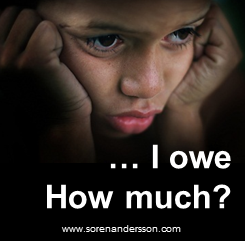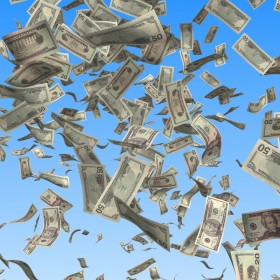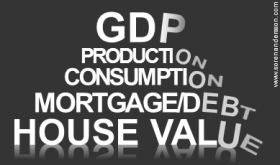
Just the other day I watched a Swedish documentary* about the European financial crisis and the recent real-estate bubble in Spain. In the documentary, largely based on scientific research by the Dutch economist Dirk Bezemer and Australian economist Steve Keen, I heard something that really left me speechless… I hope it is not true…
“For more than 30 years economists have not included Debt and Banks in the macro-economic models used for our society…”
One of the most influential Economist within the current neo-classical economic theories, Nobel prize winner Robert Lucas, stated in the documentary that “a debt is always matched by a credit, and can therefore be excluded from the model” and made it seem as simple as when you take out two equal variables from any mathematical equation if they appear on both side of the “equal to” sign…
I am neither a mathematician nor an economist but to me this seems extremely simplified and almost a little “ridiculous” – on the other hand, maybe it could explain how we ended up in the precarious economic situations we are facing, again and again…
It also seems as if the current models, works with the assumption that everything is linear and can go on for ever (Infinite growth and Infinite increase of value).
 If the question whether a debt can be repaid or not ”is not part of the model”, we probably are in serious trouble – almost every country in the world already have considerable debt, debts that are “guaranteed” with the ability of a country’s economy (GMP) to generate “surplus” enough in the future to pay interests and eventually repay the debt.
If the question whether a debt can be repaid or not ”is not part of the model”, we probably are in serious trouble – almost every country in the world already have considerable debt, debts that are “guaranteed” with the ability of a country’s economy (GMP) to generate “surplus” enough in the future to pay interests and eventually repay the debt.
“Let the future pay for itself us as well…”
Since a balanced economy “only” covers its own costs, the way to generate this “surplus” is to create growth. Today this often is generated/stimulated through more or “cheaper” credits, from Banks, financial institutions and governments, which increase the debt – and the giant “Ponzi-scheme” keeps on growing…
“What would happen if, let’s say a small Mediterranean country, starts having trouble paying its interests… what if it was a country with a larger economy…”
“What if 80% of the fossil-fuels that we already know of are impossible to exploit because our planet will “boil” if we do so…will that have any effect on economy…”
Money from thin air…
Our financial and monetary system has changed from a system to trade goods or services (bartering) where money was a “value-carrier” with direct connection to the real economy, to make transactions more convenient.
 Today, banks actually create money from thin air.
Today, banks actually create money from thin air.
There is no fixed amount of resources (money) in the system – the amount of debt is basically depending on expectations of how profitable or costly different “financial products” in a Banks “portfolio” are over time, balance being one of the key issues.
There are of course set rules on how this balance is allowed to vary, there are all kinds of “stress-tests” etc. to safeguard that banks behave, that bank have solidity to cover deposited money etc. However, over time the complexity in the global finance system, the variety of financial products etc. has grown enormously. and, judging from some recent spectacular “issues”, it is questionable whether regulatory systems have adapted at the same pace.
Only in the US the finance sector has tripled since the 1980:s – a significantly larger growth then that of the real economy during the same period. This has also led to a more and more debt-driven economic growth. More and more of the money have also been reinvested in speculative ventures within the finance sector instead of being invested in the real economy.
A debt-driven economy
Over the last decade or so, our economy has become more and more debt-driven. This is normally not a problem, if the money is spent on something that can create revenue or increase in value and thereby create enough “surplus” to pay back the debt plus interest, if money instead is used on speculations or consumption there “might be” a problem.
 The debt per household ratio has increased significantly in the last couple of decades. Favourable interest-rates from central-banks, banks and financial institutions, together with a belief in “infinite” increase in property value have made it possible for many households to invest in expensive houses, cars, boats etc. and still have a large portion of their income available for consumption. Ability to pay back loans has not been an issue – but what if property value isn’t going to increase “infinitely”, what if the economy cannot grow “infinitely”…
The debt per household ratio has increased significantly in the last couple of decades. Favourable interest-rates from central-banks, banks and financial institutions, together with a belief in “infinite” increase in property value have made it possible for many households to invest in expensive houses, cars, boats etc. and still have a large portion of their income available for consumption. Ability to pay back loans has not been an issue – but what if property value isn’t going to increase “infinitely”, what if the economy cannot grow “infinitely”…
…suppose a city, once known for its large production of vehicles, all of a sudden finds out that production has declined or moved elsewhere – any chance this could “undermine” tax-revenues, interest from investors etc. and lead to a downward spiral, even to a bankruptcy at some point…
Income Gap is irrelevant for the economy…
According to neo-classical economic theories, income inequality is not a problem – “because the rich can invest in new business that generates more jobs and so on” – and thereby everybody gains…
Problem is – This is not what has happened. To a very large extent the 5% very rich have instead invested in speculation within the finance sector or credit-activity for the other 95% and thus only increased the debt – creating, more or less, a “Perpetuum-Mobile”…
(Read more)
When looking at the income gap it is almost “scary” how well the macro-economic model used for the last 30 years fits with the income-gap development during the same period. Productivity per employee has increased considerably during this period, but wages have not. Profits and remunerations to corporate executives on the other hand have increased enormously and the income gap has never been wider.
Global Wealth Inequality
(3:52 min)
Wealth Inequality in America
(6:24 min)
During the last 30 years or so State leaders, such as Margaret Thatcher, Ronald Reagan, George Bush and several others in many countries, have tirelessly proclaimed that “the market is always right”. Also in Sweden during periods with varying Socialist and more “right-wing” majority there has been a continuous strive to increase profits and dividends to shareholders at the expense of keeping wage-increases at a reasonable (low) level.
…I wonder, is this just a coincidence or is this also somehow connected to this macro-economic model, referred to in the documentary…
Where do we go from here?
Returning to the documentary, Jörg Asmussen, European Central Bank (ECB) summarizes his findings in the aftermath from the most recent (ongoing) European finance crisis, and states that the Finance sector has become too big. His statement is supported by the International Monetary Fund (IMF) which also adds that “the finance sector should be halved – to not act Maliciously ”
I don’t really know how to end this article – I am still kind of speechless – the magnitude of all these circumstances and interconnections is simply overwhelming. Just think of it – a Finance sector possibly acting “Maliciously…” in our society – and it’s not a Movie…
Working with Sustainability, I wish that Economists, State leaders and Executives would consider to give the IPCC Climate models, which is founded on thorough scientific research, just a fraction of the amount of trust they have given to the current macro-economic models, which, according to former chief economist of the World Bank and Nobel prize winner Joseph Stiglitz, “Has no theoretical justification”… [Sarcasm]
We need to reset the System, somehow…
*) The Documentary referred to in this article is available, although mainly in Swedish, on SVT-Play until July 15, 2015 – “Vetenskapens Värld, del 6: Ekonomernas Skuld”
http://www.svtplay.se/video/1340253/del-6-av-8-ekonomernas-skuld
Tip of the day:
Dont miss the DOX-documentary “Inside Job” about the Financial Crisis (“Outrageous”).
Showing on Swedish Television 8 Aug, 2013 at 21:00, SVT1.
http://www.imdb.com/title/tt1645089/
https://itunes.apple.com/us/movie/inside-job/id418784642